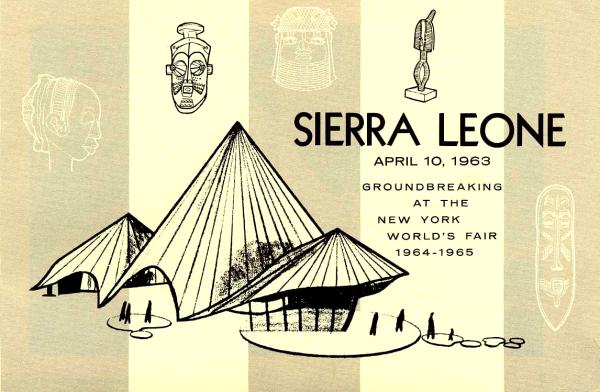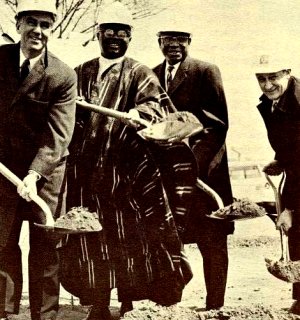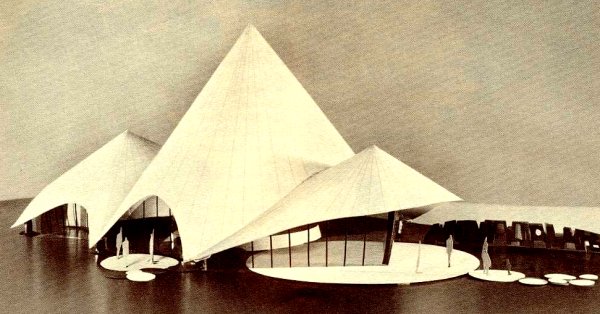 |
SOURCE: Groundbreaking
Brochure, The Pavilion of Sierra Leone
|
Excerpts from a transcription
of remarks by officials of the World's Fair and Sierra Leone,
at the at the Pavilion of Sierra Leone groundbreaking ceremony,
New York World's Fair, Wednesday, April 10, 1963.
MR. ALLEN E. BEACH [Director,
International Exhibits]: This is an important day for the New
York World's Fair and for Sierra Leone. Sierra Leone is the first
African nation to break ground for its pavilion. April is an
important month for this proud nation; two years ago, on April
27, 1961, Sierra Leone gained its independence. Sierra Leone
is small in size only; it has a big story to tell to the world
through its pavilion at this Fair. Sierra Leone, strategically
located on the west coast of Africa, is an enterprising, energetic
nation with a background of culture and tradition that millions
of Fair visitors will find most interesting.
Consul General Claudius Gibrilla
has been the Fair's principal contact for many months, and Dr.
George Bennett of our International Division staff will attest
to the fact that his sincerity in projecting his personal belief
that his country must be represented convinced us from the onset
that in him we were not only dealing with a distinguished government
official, but with a warm friend.
On June 18, 1961, shortly after
Sierra Leone's declaration of independence, Governor Poletti,
Dr. L. Gray Cowan, director of African Studies at Columbia University,
and Mr. Marcel Duriaux, who at that time was executive secretary
of the Unites States Society of Editors and Commentators, arrived
in Freetown to present the official invitation to participate
in the New York World's Fair. On this occasion, Dr. John Karefa-Smart,
Minister of External Affairs, told the delegation that Sierra
Leone would be present. Since that time, consistent and efficient
progress has been made. Mr. Costas Machlouzarides has been appointed
architect for the building that will shortly be erected here
on the Avenue of Africa.
|
William Berns, vice president
of Communications of the New York World's Fair; His Excellency,
Ambassador Richared E. Kelfa-Caulker; Consul-General Claudius
A. Gibrilla and Allen E. Beach.
 |
|
We are proud and honored that
Sierra Leone will exhibit at our Fair. Thank you.
HIS EXCELLENCY, AMBASSADOR RICHARD
E. KELFA-CAULKER: I would like to start by quoting two old sayings
that you might hear in the market places and elsewhere in Freetown.
The first is: People are counting the big yams by the dozen,
and in between a little one rolls along to be counted too. It
seems to me that our presence here in the midst of the grandeur
of these great pavilions being erected gives us the feeling that
we too, however little, want to be counted.
The other saying is: If a little
child sits near a big man and listens, he will learn a great
deal. Perhaps this is our motive for coming here - that we might
learn from the things that we shall see, as well as have an opportunity
to help people come to know us.
|
|
Sierra Leone is the oldest and
first British colony in West Africa. She therefore had a hand
in the opening up of West Africa through education, through the
Christion religion, and through commerce. Ours is a small country,
and we shall advance by mingling with the peoples of the world
at this great Fair. We are endowed with the same intelligence,
the same spirit for advancement, and we believe not only that
we have a contribution to make, but especially that through our
association with the Fair, we shall learn and profit equally
from the experience of all peoples and nations.
In 1460, Portuguese navigator
Pedro de Centra discovered Sierra Leone, which means Mountain
of the Lion. This discovery led to the institution of slavery
for which Sierra Leone became a trading base. It also led to
the establishment of the first free colony in Africa, a colony
conceived in liberty and dedicated to the proposition that all
men are created free. In the continuing pursuit of this freedom
we will come to the Fair in the year 1964 to present Sierra Leone
to America, and to the West, not in slavery, but in freedom;
not in ignorance but with intelligence. Only time will tell the
results of our efforts. We will hope for mutual understanding.
We will appreciate what is good, for we will come to learn with
eyes wide open.
|
|
We trust that in presenting the
spirit of Sierra Leone, we shall help America and the West to
see not only Sierra Leone but Africa as a whole, her potential
and her present needs.
Mr. Chairman, it is a great pleasure
to take part in this groundbreaking ceremony to establish the
Pavilion of Sierra Leone at the New York World's Fair. Thank
you.
WILLIAM BERNS: Supported by the
enthusiasm and interest of the executives and staff of the New
York World's Fair for the participation of the African nations,
it is a pleasure to bring you this message from the president
of the New York World's Fair, the Honorable Robert Moses:
"We are delighted with this
participation by one of the ambitious new nations of West Africa,
a nation aiming at the same objectives and with the same democratic
principles as ours. The design of your pavilion is particularly
attractive - I assume your exhibits will be equally impressive.
I look forward to greeting you when the Fair opens.
|
|
|
Model of Pavilion of Sierra
Leone, an ultra-modern structure that conveys the romantic traditions
of this new western African nation. Its exhibits will tell the
story of Sierra Leone, from a slave colony to proud independence.
 |
|
|